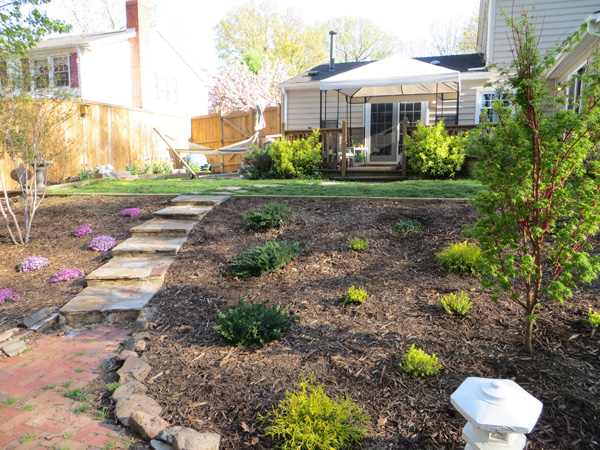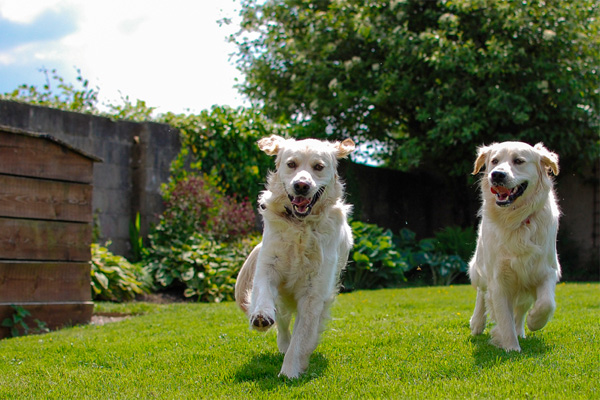Landscaping Dos and Don’ts When You Have a Dog
Your dog may be your best friend, but he’s not your yard’s BFF. Here are some guidelines to help you all get along.
DO: Give up the idea of having a perfect yard — a place that’s perfect for you and your pet is better.
DON’T: Let your dog rule the roost. Train him to respect boundaries and do his business in a designated spot.
DON’T: Let your dog rule the roost. Train him to respect boundaries and do his business in a designated spot.
DO: Create a water feature so your dog can cool off on hot days.
DON’T: Install a pond or pool that is hard for your dog to enter and exit.
DO: Add a sandbox your dog can feel free to dig in. Bury bones and treats at first to pique his interest.
DON’T: Think that sandboxes are maintenance-free. Keep a shovel and rake nearby to cover holes and clean waste.
Related: How to Stop Your Dog From Digging in Your Yard
DO: Use gravel, shredded hardwood mulch, or wood chips, which won’t stick to longhair coats.
DON’T: Use cocoa mulch, which may contain theobromine, the same ingredient that makes chocolate poisonous to dogs.

Image: Down to Earth Landscaping, Inc. of Bellevue, WA
DO: Edge flowerbeds with rocks or foot-tall shrubs to protect your posies.
DON’T: Use a metal edging that can cut your pooch.
DO: Select plant species that reduce fleas, such as lavender, rosemary, and mint, and others that are good for dogs to eat — blueberries, strawberries, wheat grass, and oat grass.
DON’T: Select plants that can make your dog sick, like foxglove, iris, monkshood, and lily of the valley.
DO: Landscape with urine-resistant plants, such as Euonymus japonica (Japanese spindle tree) and Burkwood osmanthus.
DON’T: Freak out when you find yellow and brown spots in your lawn caused by urine. Reseeding is a simple and easy cure for those spots. Or create a potty station.
Related: Why is My Grass Turning Brown?
DO: Create paths or walkways along routes your dog already travels.
DON’T: Think you can redirect your dog away from areas he’s already claimed. Don’t resort to planting thorny shrubs or other plants to deter him. You’ll both be sorry.

Image: MaryLea Harris
DO: Use organic fertilizers, herbicides, and pesticides on lawns and plants.
DON’T: Spread toxic lawn and plant care products, which can harm dogs. A National Institute of Health study showed that professionally applied pesticides were associated with a 70% higher risk of canine malignant lymphoma.
DON’T: Install a pond or pool that is hard for your dog to enter and exit.
DO: Add a sandbox your dog can feel free to dig in. Bury bones and treats at first to pique his interest.
DON’T: Think that sandboxes are maintenance-free. Keep a shovel and rake nearby to cover holes and clean waste.
Related: How to Stop Your Dog From Digging in Your Yard
DO: Use gravel, shredded hardwood mulch, or wood chips, which won’t stick to longhair coats.
DON’T: Use cocoa mulch, which may contain theobromine, the same ingredient that makes chocolate poisonous to dogs.

Image: Down to Earth Landscaping, Inc. of Bellevue, WA
DO: Edge flowerbeds with rocks or foot-tall shrubs to protect your posies.
DON’T: Use a metal edging that can cut your pooch.
DO: Select plant species that reduce fleas, such as lavender, rosemary, and mint, and others that are good for dogs to eat — blueberries, strawberries, wheat grass, and oat grass.
DON’T: Select plants that can make your dog sick, like foxglove, iris, monkshood, and lily of the valley.
DO: Landscape with urine-resistant plants, such as Euonymus japonica (Japanese spindle tree) and Burkwood osmanthus.
DON’T: Freak out when you find yellow and brown spots in your lawn caused by urine. Reseeding is a simple and easy cure for those spots. Or create a potty station.
Related: Why is My Grass Turning Brown?
DO: Create paths or walkways along routes your dog already travels.
DON’T: Think you can redirect your dog away from areas he’s already claimed. Don’t resort to planting thorny shrubs or other plants to deter him. You’ll both be sorry.

Image: MaryLea Harris
DO: Use organic fertilizers, herbicides, and pesticides on lawns and plants.
DON’T: Spread toxic lawn and plant care products, which can harm dogs. A National Institute of Health study showed that professionally applied pesticides were associated with a 70% higher risk of canine malignant lymphoma.
Read more: http://www.houselogic.com/home-advice/landscaping-gardening/landscaping-for-dogs/#ixzz32NcCpny9
Follow us: @HouseLogic on Twitter | HouseLogic on Facebook

 You can create an outdoor space that both you and your pooch will love with a few simple landscaping tweaks, like switching to organic, pet-friendly fertilizers. Image:
You can create an outdoor space that both you and your pooch will love with a few simple landscaping tweaks, like switching to organic, pet-friendly fertilizers. Image: 
No comments:
Post a Comment